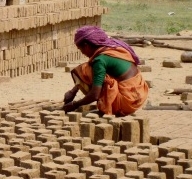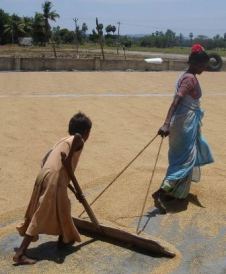India: the bond of freedom
Interview with Mr Saju Mathew, National Director, International Justice Mission, India
 Recently UNODC interviewed Mr. Mathew to understand what bonded labor means, its links to human trafficking and how to combat it.
Recently UNODC interviewed Mr. Mathew to understand what bonded labor means, its links to human trafficking and how to combat it.
UNODC: You have been working for International Justice Mission (IJM) for a while. Could you briefly explain the work of IJM in India?
IJM: IJM's mission is to secure justice for victims of violent oppression, and in India, we've found that this oppression often takes one of two forms: forced prostitution or bonded labour. Our field offices in Mumbai and Kolkata partner with local governments to bring the protection of the law to victims of forced prostitution, and our Bangalore and Chennai offices address instances of bonded labour in brick kilns, rice mills, rock quarries and salt works. Since the inception of our forced labour casework in India in 2000, we have assisted the government in conducting 101 rescue operations, freeing over 3000 bonded labour victims, 96 percent of whom have remained free since their release from bondage. What we've learned over the last ten years is that if we hope to achieve our goals of eliminating these threats to our nation's poor, we must take a comprehensive approach that not only seeks to rescue victims from their oppressors, but also puts them on a path to recovery and independence, while simultaneously seeking punitive measures against perpetrators. Finally, we must equip and encourage the appropriate government-appointed institutions to do this work themselves.
UNODC: UNODC deals with issues relating to human trafficking. Human trafficking can also take place with the purpose of bonded labour. Can you explain what bonded labour means, as well as its nature and scope in India and even South Asia if possible?
IJM: It is impossible to discuss bonded labour without mentioning human trafficking because, to their owners and traffickers,

While expert estimates vary on the number of bonded labourers with National Geographic Magazine estimating 27 million bonded labourers worldwide, and the National Institute for Human Rights in Bangalore putting the figure at a staggering 65 million in India alone, all studies agree on one point: there are more bonded labourers in South Asia than any other region in the world, labouring in industries including agriculture, rice mills, brick kilns, rock quarries, salt production, textiles, cigarettes, gem polishing and domestic work.
UNODC: Can you tell us what needs to be done to eliminate bonded labour? What does the Government have to do, and what can the civil society do?
IJM: The elimination of bonded labour requires a holistic approach. Over the last ten years, we've identified two major factors that drive bonded labour systems: victim vulnerability and perpetrator impunity. The elimination of these factors requires a dual approach that involves the government, NGOs, and society at large. Central, state, and district governments must provide sufficient economic opportunities to the poor. At the same time, immediate action must be taken to decrease the demand for bonded labour by enforcing existing laws.
Recently, a repeat-offender of bonded labour crimes in Tamil Nadu, India was handed a five-year rigorous imprisonment sentence. Landmark judgments like this radically change the economic equation for potential perpetrators and compel facility owners to think twice about utilizing bonded labour in their industries. As members of the general public, we must support our political leadership in their efforts to respond to this crime.
UNODC: Could you tell us about the institutions that are in place in India that address bonded labour?
IJM: In India, there are many excellent legal tools that the government has established for combating bonded labor. The Bonded
 Labour System (Abolition) Act (BLA) of 1976 continues to be the primary legislation used in dealing with bonded labour cases. In addition, the Indian Penal Code (IPC) includes two slavery offences - buying or disposing of a person as a slave, and habitually dealing in slaves.
Labour System (Abolition) Act (BLA) of 1976 continues to be the primary legislation used in dealing with bonded labour cases. In addition, the Indian Penal Code (IPC) includes two slavery offences - buying or disposing of a person as a slave, and habitually dealing in slaves.
The BLA also empowers the State Government to identify, release and rehabilitate victims of bonded labor. This power lies with District Magistrates, who must grant formal release certificates to identified victims of bonded labour. These certify that the victim's bonded debt is extinguished, and entitle them to government rehabilitation funds (currently Rs. 20,000 per victim). In addition, the BLA includes provisions for the creation of Vigilance Committees. These committees consist of government officials as well as members of the public who address the issue of bonded labour in the community and report its prevalence.
UNODC: This is laudable work, but the problem seems so big. In your opinion what more needs to be done to address this problem?
IJM: If we hope to see the end of bonded labour, the general public must communicate to government officials that they wish to see the problem of bonded labour taken seriously and the government, in turn, must enforce bonded labour laws. As one of the government officials we work with recently told us, "first, awareness should be created. For example, everyone knows that we need to administer drops to eradicate polio. So everybody has started taking polio drops for children. We need that same type of awareness for bonded labour. Just like polio, bonded labour is a disease that needs to be eradicated."